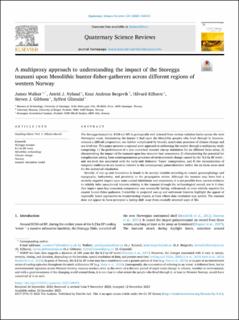| dc.contributor.author | Walker, James William Paddison | |
| dc.contributor.author | Nyland, Astrid Johanne | |
| dc.contributor.author | Bergsvik, Knut Andreas | |
| dc.contributor.author | Kilhavn, Håvard Parathan | |
| dc.contributor.author | Gibbons, Steven John | |
| dc.contributor.author | Glimsdal, Sylfest | |
| dc.date.accessioned | 2024-04-24T11:19:46Z | |
| dc.date.available | 2024-04-24T11:19:46Z | |
| dc.date.created | 2023-12-11T10:28:29Z | |
| dc.date.issued | 2023 | |
| dc.identifier.citation | Walker, J., Nyland, A. J., Bergsvik, K. A., Kilhavn, H., Gibbons, S. J., & Glimsdal, S. (2024). A multiproxy approach to understanding the impact of the Storegga tsunami upon Mesolithic hunter-fisher-gatherers across different regions of western Norway. Quaternary Science Reviews, 324, 108433. | en_US |
| dc.identifier.issn | 0277-3791 | |
| dc.identifier.uri | https://hdl.handle.net/11250/3127925 | |
| dc.description.abstract | The Storegga tsunami (c. 8150 cal BP) is geologically well attested from various isolation basins across the west Norwegian coast. Ascertaining the impact it had upon the Mesolithic peoples who lived through it, however, remains a difficult proposition; one further complicated by broadly synchronic processes of climate change and sea-level rise. This paper presents a regional scale approach to addressing this matter through a multiproxy study comprising: 1) the performance of a new numerical tsunami run-up simulation for six different focus areas; 2) characterising the impact of the tsunami upon key resource base ecosystems; 3) characterising the potential for complication arising from contemporaneous processes of environmental change caused by the ‘8.2 ka BP event', and sea-level rise associated with the early-mid Holocene ‘Tapes’ transgression, and 4) the reconstruction of temporal traditions in site location relative to the contemporary palaeoshoreline within the six focus areas used for the numerical simulation.
Severity of run-up and inundation is found to be acutely variable according to coastal geomorphology and topography, bathymetry, and proximity to the propagation centre. Although the tsunami may have had a severely negative impact upon some coastal inhabitants and ecosystems, it is not possible from current evidence to reliably infer unequivocal impacts relating to the tsunami through the archaeological record, nor is it clear that impact upon key ecosystem components was necessarily lasting, widespread, or even entirely negative for coastal hunter-fisher-gatherers. Variability in projected run-up and settlement histories highlight the appeal of regionally based approaches to reconstructing impact, at least where data resolution may permit. The tsunami does not appear to have prompted a lasting shift away from coastally oriented ways of life. | en_US |
| dc.language.iso | eng | en_US |
| dc.publisher | Elsevier | en_US |
| dc.rights | Navngivelse 4.0 Internasjonal | * |
| dc.rights.uri | http://creativecommons.org/licenses/by/4.0/deed.no | * |
| dc.title | A multiproxy approach to understanding the impact of the Storegga tsunami upon Mesolithic hunter-fisher-gatherers across different regions of western Norway | en_US |
| dc.type | Peer reviewed | en_US |
| dc.type | Journal article | en_US |
| dc.description.version | publishedVersion | en_US |
| dc.rights.holder | The authors | en_US |
| dc.subject.nsi | VDP::Humaniora: 000::Arkeologi: 090 | en_US |
| dc.source.volume | 324 | en_US |
| dc.source.journal | Quaternary Science Reviews | en_US |
| dc.identifier.doi | 10.1016/j.quascirev.2023.108433 | |
| dc.identifier.cristin | 2211586 | |
| dc.relation.project | Norges forskningsråd: 302858 | en_US |
| cristin.ispublished | true | |
| cristin.fulltext | original | |
| cristin.qualitycode | 2 | |

